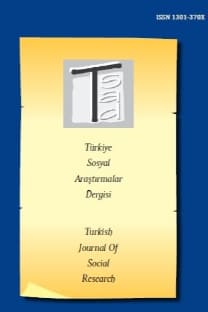Gender and property: An analysis of inequalities in distribution of property and control over property
Bu çalışmanın amacı Doğu Karadeniz Bölgesinde yer alan orta büyüklükteki bir ilçede cinsiyetler arasında mülk dağılımı ve mülk sahipliği kalıplarının bir analizinin sunulmasıdır. çözümlemeye çalışmaktadır. Çalışma bir statü etkeni olarak toplumsal cinsiyetin mal sahipliği ve kontrolü örüntüleri üzerindeki etkisini ve ailelerde malların bir kuşaktan diğerine aktarılmasında genel olarak ne tür stratejilerin kullanıldığını belirlemeyi amaçlamaktadır. Veriler mülkiyetin dağılım ve kontrolünde cinsiyetler arasında belirgin farklılıkların olduğunu göstermektedir. Çözümleme aynı zamanda cinsiyet temelli miras uygulamaları ve stratejilerinin kadınların mülk sahipliğini ve mülkiyet kontrolünü önemli bir düzeyde sınırlandırdığını işaret etmektedir.
Cinsiyet ve varlık: Varlık ve varlık kontrolü dağılımındaki eşitsizliğin anali
The purpose of this study is to describe patterns of distribution of property and property ownership between sexes in the context of a medium-sized town, located in the Black Sea region. It aims to demonstrate that gender, as a status factor, has an impact on patterns of property holdings and control over property, and to determine kinds of strategies used by families in the case of transmission of properties from one generation to the next. Data indicate that there are marked differences in the distribution of property and control of property. Analysis also points out that gender-based inheritance practices and strategies severely restrict women’s ownership of property and control over property.
___
- Adak, Ö. N ve Cömertler, N. (2005), “Türkiye’de Akademide ve Akademik Yönetimde Kadınlar”, Sosyoloji Araştırmaları Dergisi, 8 (2), 5-22.
- Akatlı, F. (1981), “The Image of Woman in Turkish Literature”, N. Abadan- Unat (Ed.), Women in Turkish Society, E.J. Brill, Leiden.
- Arat, N. (1996), “Women’s Studies in Turkey”, Women’s Studies Quarterly. 24.
- Bourdieu, P. (1976), “Marriage Strategies as Strategies of Social Reproduction”, R. Forster and O. Ranum (Ed.), Family and Society: Selections from the Annales. The Johns Hopkins University Press, Baltimore.
- Coşkun, M.K ve Ünal, B. (2005) “Kayıtdışı Ekonomide Gündelikçilik”. Sosyoloji Araştırmaları Dergisi” 8, 831-56
- Daver, B. (1968), “Political Rights of Women”, Ankara Universitesi Siyasal Bilgiler Fakültesi Dergisi, 23.
- Dedeoğlu, S. (2000), “Toplumsal cinsiyet rolleri açısından Türkiye’de aile ve kadın emeği”, Toplum ve Bilim, 86.
- Delaney, C. (1991), The Seed and the Soil; Gender and Cosmology in Turkish Village Society, Oxford: University of California Press, Berkeley, Los Angeles.
- Ertürk, Y. (1991), “Convergence and Divergence in the Status of Moslem Women: The Cases of Turkey and Saudi Arabia”. International Sociology, 6
- Goody, J. (1990), The Oriental, the Ancient, and the Primitive. CUP, Cambridge.
- İlcan, S. (1996), “Fragmentary Counters in a Moral World: Household Power Relations and Gender Politics”, Ethnology 35.
- Kağitçıbaşı, C. (1986), “Status of Women in Turkey: Cross-Cultural Perspectives”. International Journal of Middle-Eastern Studies,18.
- Kandiyoti, D. (1980), Major Issues on the Status of Women in Turkey: Approaches and Priorities, Çağ Matbaasi, Ankara.
- Kazgan, G. (1981), “Labour Force Participation, Occupational Distribution, Educational Attainment and the Socio-Economic Status of Women the Turkish Economy”. N. Abadan-Unat (Ed.), Women in Turkish Society, E.J. Brill, Leiden.
- Kıray, M. B. (1981), “The Women of Small Town”. N. Abadan-Unat (Ed.), Women in Turkish Society, E.J. Brill, Leiden.
- Lewis, B. (1961). The Emergence of Modern Turkey. Oxford University Press, Londra.
- Magnarella, P. J. (1973). “The Reception of Swiss Family Law in Turkey”, Anthropological Quarterly, 46.
- Magnarella, P. J. (1974), Tradition and Change in a Turkish Town. John Wiley and Sons, New York.
- Mann, M. (1986), “A Crisis in Stratification Theory: Persons, Households, Families, Lineages, Genders, Classes and Nations”, R. Crompton ve M.
- Mann (Ed.), Gender and Stratification, Polity, Cambridge.
- Morvaridi, B. (1993), “Gender and Household Resource Management in Agriculture: Cash Crops in Kars”, P. Stirling (Ed.), Culture and Economy: Changes in Turkish Villages. The Eothen Press, Cambs.
- Özbay, F. (1979), “Kirsal Yorelerde Kadinin Statüsü, İsgücüne Katılımı ve Eğitim Durumu”, AİTİA Yönetim Bilimleri Fakültesi Dergisi, I.
- Scott, J. (1996), Stratification and Power: Structures of Class, Status and Command. Polity Press, Cambridge.
- Starr, J. (1984), “The Legal and Social Transformation of Rural Women”, R. Hirschon (Ed.), Women and Property - Women as Property. St. Martin’s Press, New York.
- Starr, J. (1989), “The Role of Turkish Secular Law in Changing the Lives of Rural Muslim Women, 1950-1970”, Law and Society Review, 23.
- Sümer, S. (1998), “Incongruent Modernities: A Comparative Study of Higher Educated Women from Urban Turkey and Norway”, Acta Sociologica, 41.
- Taşkıran, S. (1973), 50. Yilinda Turk Kadin Haklari, Basbakanlik Yayinlari, Ankara.
- Tekeli, Ş. (1982), Kadın ve Siyasal-Toplumsal Hayat, Birikim yayınları, İstanbul.
- Toprak, B. (1981), “Religion and Turkish Women”, N. Abadan-Unat (Ed.), Women in Turkish Society. E.J. Brill, Leiden.
- Ulusoy, D. (2001). “Traditional Gender Patterns in Education Area in Turkey”, KÖK Araştırmalar, 3, 1.
- Weber, M. (1968). Economy and Society. University of California Press, Berkeley.
- Yanıklar, C. (2001). Class, Status and Gender. Unpublished PhD Thesis. University of Essex.
- ISSN: 1301-370X
- Başlangıç: 2015
- Yayıncı: AKADEMİSYENLER BİRLİĞİ DERNEĞİ
